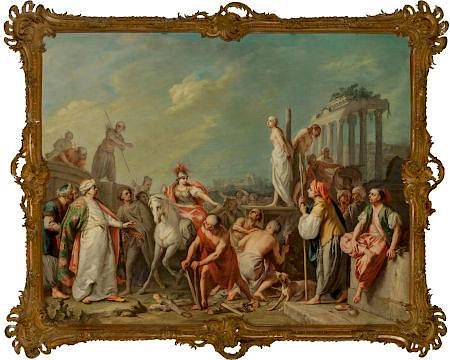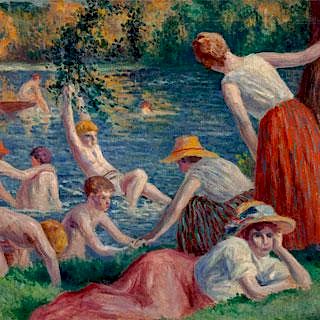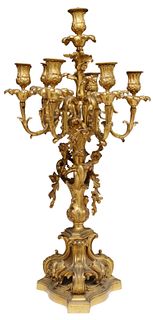Jacopo Amigoni (Italian, 1682-1752) Clorinda Rescuing Olindo and Sophronia
Lot 66036
Categories
Estimate:
$80,000 - $120,000
Absentee vs Live bid
Two ways to bid:
- Leave a max absentee bid and the platform will bid on your behalf up to your maximum bid during the live auction.
- Bid live during the auction and your bids will be submitted real-time to the auctioneer.
Bid Increments
| Price | Bid Increment |
|---|---|
| $0 | $1 |
| $10 | $2 |
| $50 | $5 |
| $100 | $10 |
| $200 | $20 |
| $500 | $50 |
| $1,000 | $100 |
| $2,000 | $200 |
| $5,000 | $500 |
| $10,000 | $1,000 |
| $20,000 | $2,000 |
| $50,000 | $5,000 |
| $100,000 | $10,000 |
| $200,000 | $20,000 |
| $500,000 | $50,000 |
| $1,000,000 | $100,000 |
| $5,000,000 | $250,000 |
| $10,000,000 | $500,000 |
About Auction
By Heritage Auctions
Dec 9, 2015 - Dec 10, 2015
Set Reminder
2015-12-09 12:00:00
2015-12-10 12:00:00
America/New_York
Bidsquare
Bidsquare : European Art
https://www.bidsquare.com/auctions/heritage/european-art-1132
Heritage Auctions Bid@HA.com
Heritage Auctions Bid@HA.com
- Lot Description
Jacopo Amigoni (Italian, 1682-1752)
Clorinda Rescuing Olindo and Sophronia, circa 1740
Oil on canvas
49-1/2 x 61-1/2 inches (125.7 x 156.2 cm)
Label (torn at right) affixed to back of frame, inscribed in pen: B 642 - / Jacopo A.../ P. 650
PROVENANCE:
L'Art Ancien, Lugano, Switzerland, circa 1921 (as featured in that firm's catalogue no. 1, in which the painting was priced at 4,000 Swiss francs);
Collection of Pat Newbern, Dallas, acquired circa 1960s;
By descent to the present owner.
The lovers standing in this doleful wise,
A warrior bold unwares approached near,
In uncouth arms yclad and strange disguise,
From countries far, but new arrived there,
A savage tigress on her helmet lies,
The famous badge Clorinda used to bear;
That wonts in every warlike stowre to win,
By which bright sign well known was that fair inn. (1)
The present painting represents the dramatic rescue of the two lovers, Sophronia and Olindo, as recounted in Torquato Tasso's epic poem, Gerusalemme liberata, which he completed in 1575. The text was first published in Parma, 1581, and a first, illustrated edition appeared in 1590. Tasso's Renaissance classic was set during the First Crusade, which ended with Godfrey de Bouillon's heroic liberation of Jerusalem in 1099. It included fanciful accounts of trysts and other escapades, including the tale of the two lovers, which is recounted in Book 2, cantos XXXII-XLV. Gerusalemme liberata enjoyed a huge success throughout Europe and was celebrated in music and art for the next two centuries.
The Christian Sophronia was condemned to death by the king of the Saracens for her supposed involvement in a plot to desecrate an Islamic image. The means of her execution was burning at the stake, and her lover, Olindo, chose to join her in death. Just as the event was about to take place, Clorinda, a female mercenary from Persia, appeared on a white stallion in full armor. She took immediate pity on the young couple and proposed to the king that, in return for their lives, she would herself continue the war against the Crusaders.
The author of this unpublished painting, the Venetian master Jacopo Amigoni, represents Tasso's tale in the foreground plane with all of its principals highlighted by areas of white pigment. At left, the Saracen king, seen in profile and robed in white satin with a lavish, pale green and rose, embroidered cloak, faces the scene of the prepared-for execution. With his extended left hand he bids the Saracen henchmen, half naked and with their heads shaved-visible at center, splitting wood and preparing to ignite the fire-to halt the immolation and so spare Sophronia and Olindo. Their rescuer, the dashing Clorinda, issues the same command, extending her left arm diagonally in the direction of the crouching figures about to light the pyre. The role of two of the more prominent foreground figures in Amigoni's narrative, however, appears anomalous. That at the center right, a young man in a red cap holding a spear, may have been included as a compositional device to bracket the scene at right. His costume seems generically Western and he is the largest scale figure in the entire group. (Does he represent, for instance, Amigoni's patron?) The other unusually-clad person is the figure to the right of the Saracen king; what nationality is he, dressed in a fur cap, and what is the meaning of the hammer in his right hand?
To the right can be made out several ruins of classical architecture. The row of Corinthian columns with an entablature may well represent the Roman ruins of the Temple of Jupiter at Baalbek, in present-day Lebanon; in Amigoni's day, these would have been read as a reference to the Holy Land. To the right of this feature can be made out the upper section of a ruined Roman arch and, in front of that, a partially visible wall with an inscription indecipherable, possibly Hebrew, letters.
Stylistic comparisons with paintings dating from the time period 1739 to early 1747, that is after Amigoni returned to Venice from Great Britain and before he relocated to Spain as first court painter to King Ferdinand VI, would indicate that he executed the present picture during this same time. The type of bearded elderly man with a hooked nose seen here in the background at left, as well as in the figure wearing a fur hat to the right of the Saracen king, also appears in two Old Testament paintings by Amigoni executed c. 1740: Sacrifice of Isaac and Lot and His Daughters (Streit Foundation, Berlin; on loan to the Gemäldegalerie, Berlin). These and another pair, Bathsheba and Susannah and the Elders (likewise in Berlin), later belonged to the Venice-based, Prussian merchant, Sigismund Streit (1687-1775), who had his portrait painted by Amigoni four times.
Amigoni's Susannah and the Elders also has features in common with Clorinda Rescuing Olindo and Sophronia. In the former painting, the portly, elderly letch, seen in profile, resembles the figure of the Saracen king, and the rather flaccid, extended left arm of Susannah recalls the gesture of Clorinda with which she commands the Saracen underlings to extinguish their torches. Certain figure types found in Clorinda Rescuing Olindo and Sophronia also reappear in The Meeting of Habrokomes and Antheia at the Feast of Diana, a painting that was ordered by Conte Francesco Algarotti for Friedrich August II of Saxony, King of Poland, for the royal gallery at Dresden in 1743. In that work, now at the Staatsgalerie, Stuttgart, the seated man in white satin and a fur-line cape at lower left, recalls (once again) the figure of the Saracen king in the present work.
(1) The text of Book 2, Canto XXXVIII, of Gerusalemme liberata by Torquato Tasso from the translation of Edward Fairfax (London, 1600), as edited by Henry Morley (New York, 1901).
The Art Loss Register certifies that this lot is not listed in their database of stolen or missing paintings.
Dimension
Height: 4950.00Width: 6150.00Condition of the painting: This work is in very good condition, retaining its rich surface detail and showing little to no evidence of surface abrasion. Glue-lined canvas; light craquelure overall commensurate with age, with some scattered areas of more moderate craquelure in the lower half of the painting, in the figures' garments, as well as in the more impastoed areas and details of the figures; under UV light, the canvas appears to be thickly varnished, with several very minor paint chips, as well as a few inpainted frame abrasions along the upper left edge, and one small area of inpainting to address an abrasion to the lower cream-colored folds of the rider's drapery.Report on the frame:The frame appears to be Italian, constructed of spruce and dating to the mid to late 19th century. The frame has a wood foundation topped with elements of wire-strengthened gesso/terracotta with Rococo-style ornamentation and scrolls to the edges. I see typical simulated aging techniques used in that period, including the application of red paint to simulate gilt wear to high points. The back of the frame has been lightly stained to simulate oxidation. The stretcher is probably a bit more contemporary, more in line with the 1920s date when the piece was reframed. Framed Dimensions 58.25 X 73 InchesCondition
- Buyer's Premium



 EUR
EUR CAD
CAD AUD
AUD GBP
GBP MXN
MXN HKD
HKD CNY
CNY MYR
MYR SEK
SEK SGD
SGD CHF
CHF THB
THB













